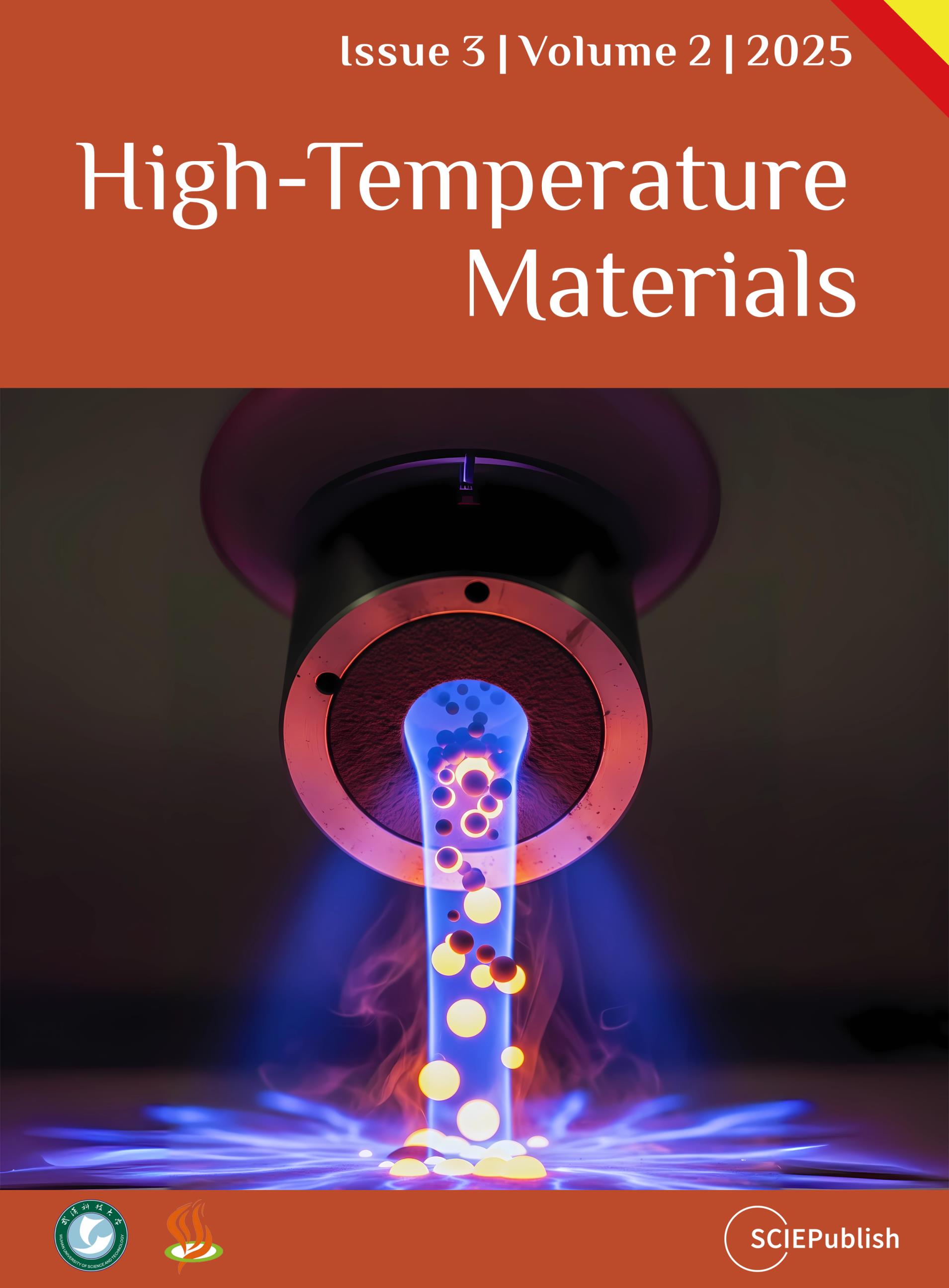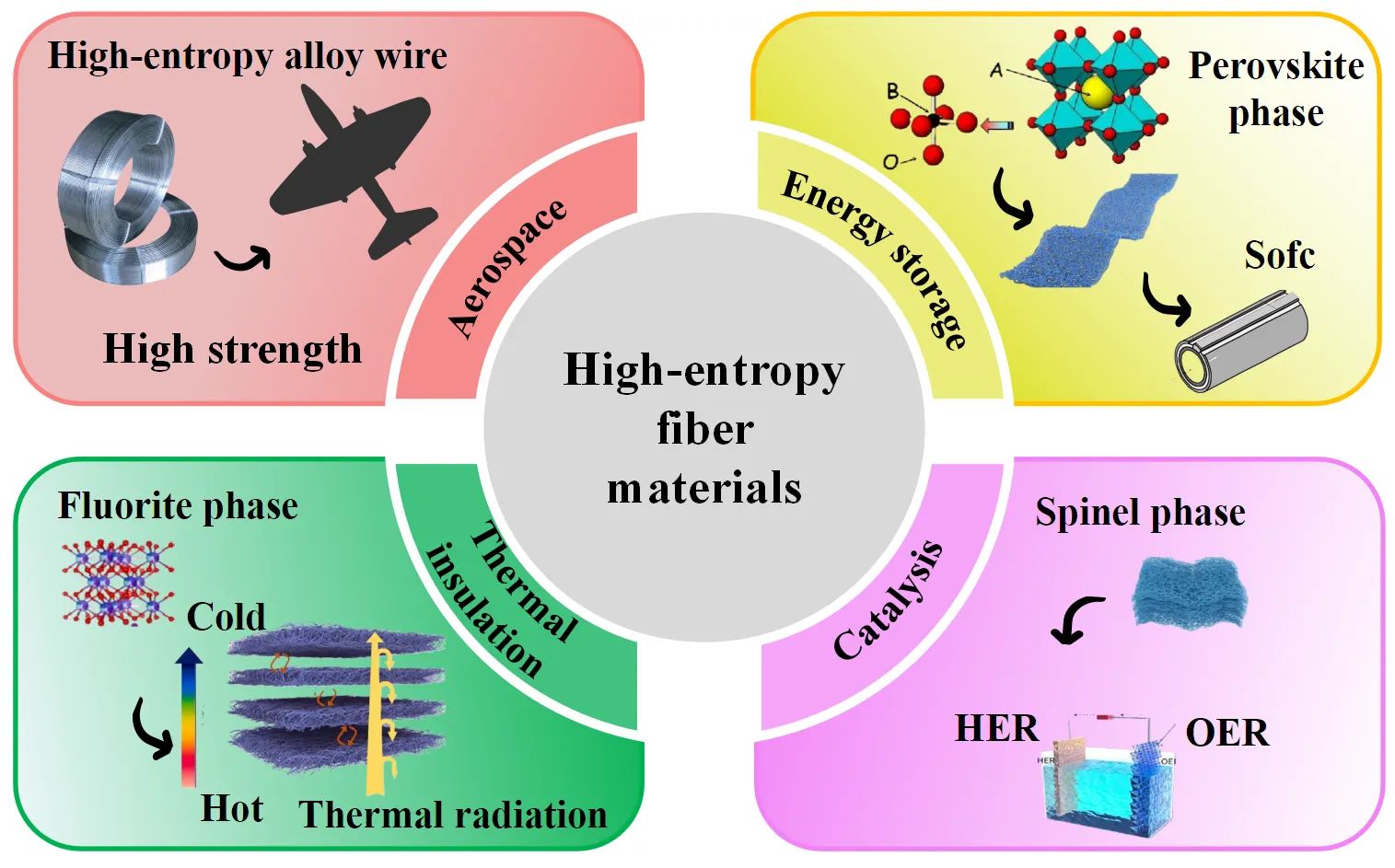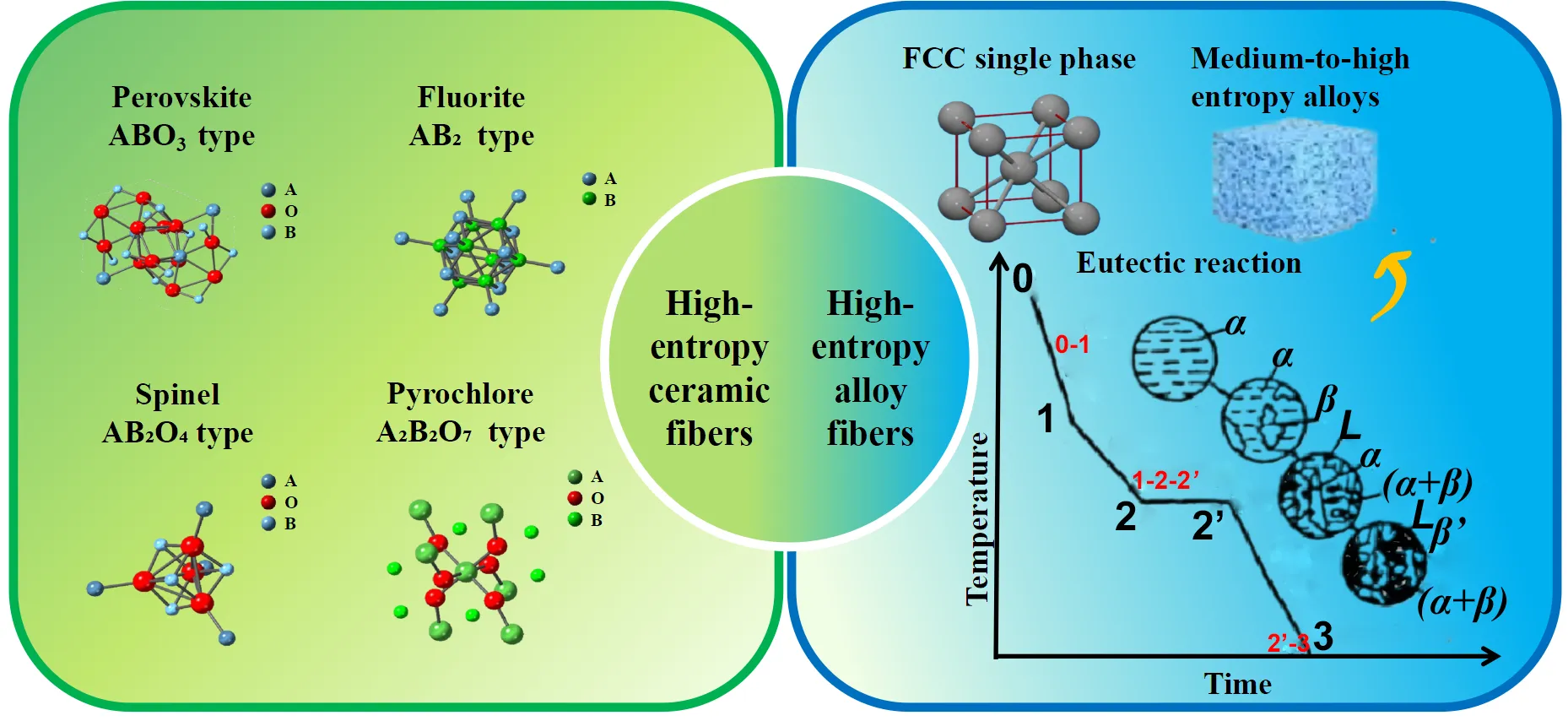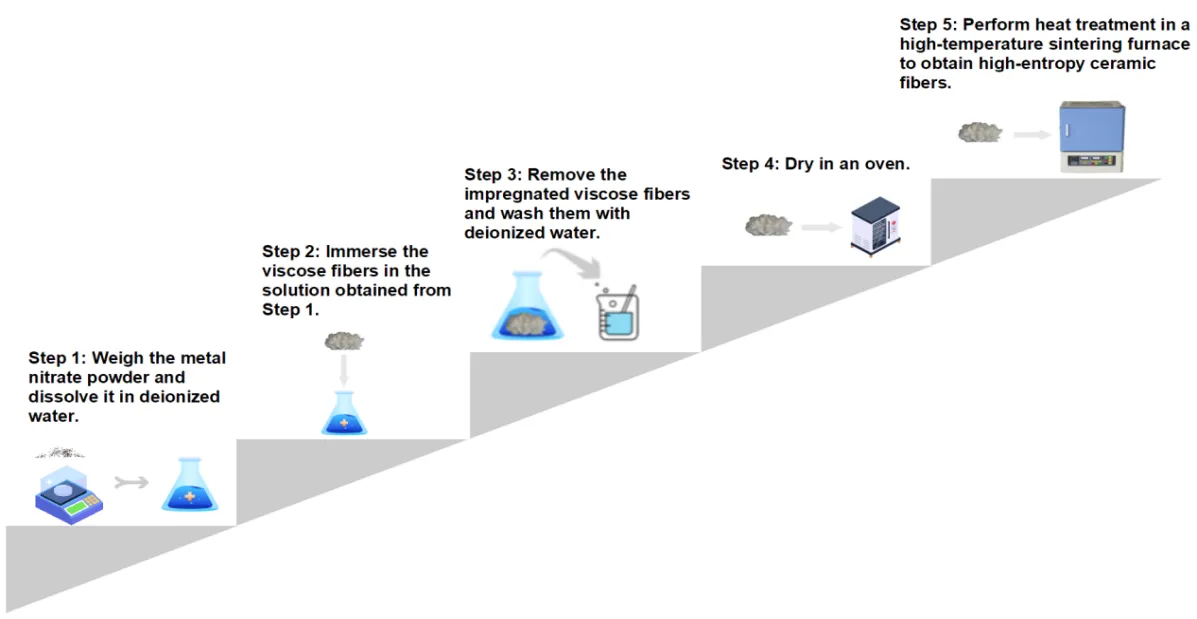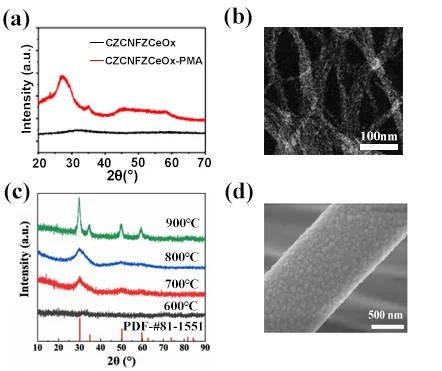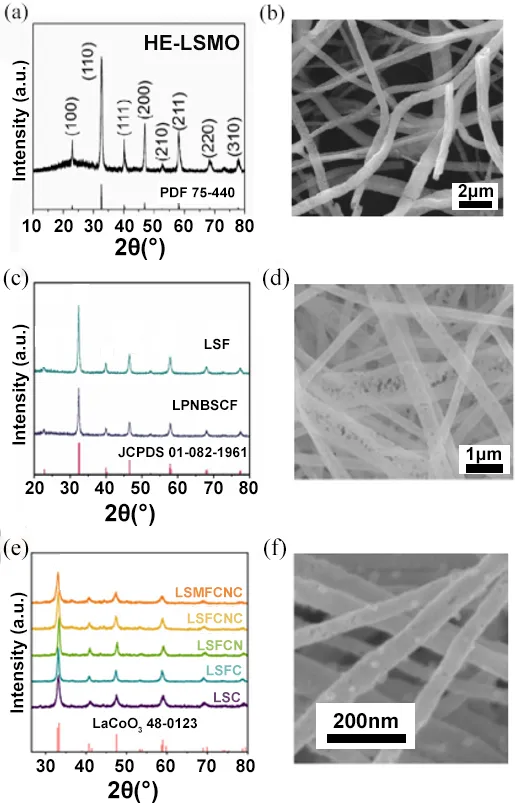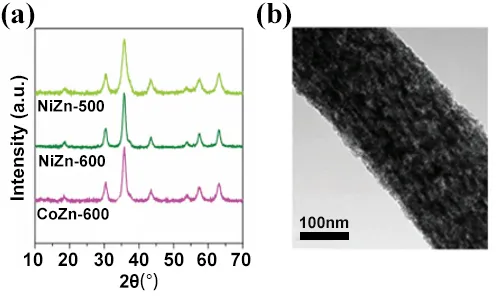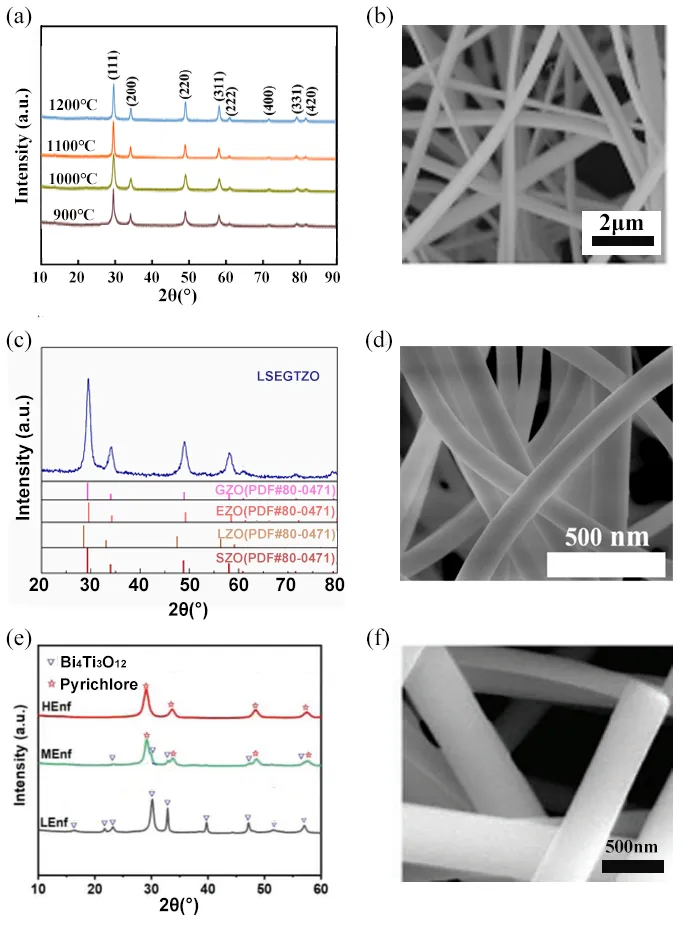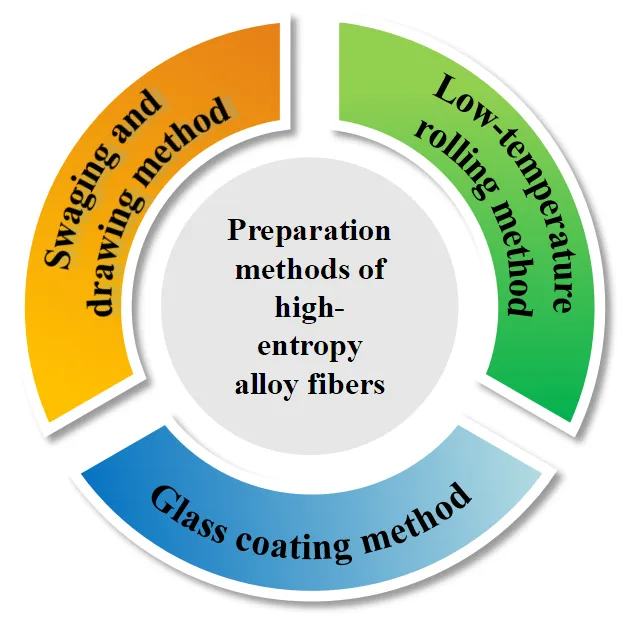High-entropy materials (HEMs) are typically defined as alloys or compounds composed of five or more principal elements, each with a molar fraction generally ranging from 5% to 35%, resulting in a near-equiatomic configuration. This compositional design leads to a high configurational entropy (commonly exceeding 1.5 R) which thermodynamically favors the formation of stable single-phase solid solution structures over conventional multiphase mixtures or intermetallic compounds. In the advancement of modern materials science, High-Entropy Materials (HEMs) have emerged as a novel class of materials that have garnered significant attention due to their unique structural characteristics and exceptional properties [
1,
2,
3]. The concept of HEMs was first introduced by Yeh et al. in 2004 and has since evolved into a pivotal research direction in the field of materials science. Unlike conventional alloys [
4], which are typically composed of a primary element with minor additions of alloying elements to optimize performance, HEMs are generally composed of five or more principal elements in near-equiatomic ratios. The high degree of compositional mixing leads to the formation of highly disordered solid solution phases, fundamentally altering the material’s microstructure and crystalline characteristics [
5,
6,
7,
8]. As a result, HEMs exhibit an expanded performance space and outstanding multifunctional properties in mechanical, thermal, electrical, and chemical aspects, making them highly promising for a wide range of applications.
In the early stages of high-entropy materials (HEMs) research, the focus is primarily on metallic alloys, particularly High-Entropy Alloys (HEAs). Compared to conventional single-principal-element fibers or traditional alloy-based fibers, HEA-based fibrous materials exhibit greater phase stability, slower diffusion kinetics, and uniform element distribution, which exhibit exceptional strength, hardness, and corrosion resistance [
4,
9,
10,
11,
12]. However, in recent years, researchers have progressively extended the high-entropy concept to various material systems, including ceramics, coatings, composites, and polymers [
13,
14,
15]. Among them, High-Entropy Fibrous Materials (HEFMs) have attracted increasing attention due to their lightweight nature, structural stability, high strength, and thermal resistance [
16,
17,
18]. These unique properties endow HEFMs with promising applications in aerospace, energy storage, catalysis, and thermal insulation, highlighting their potential as advanced structural and functional materials in diverse technological fields.
As shown in
, fibrous materials are widely utilized in structural reinforcement, functional composites, and intelligent materials [
3,
19,
20,
21,
22,
23,
24]. Traditional fibrous materials primarily rely on the optimization of a single or a limited number of components, such as ceramic and metallic fibers, whose performance is inherently constrained by their intrinsic physicochemical properties. In contrast, High-Entropy Fibrous Materials (HEFMs) have a homogeneous distribution of multiple components, resulting in unique microstructures and multi-scale interfacial effects [
3,
5,
9,
10,
25,
26,
27]. These characteristics endow HEFMs with key high-entropy effects, including the Entropy Effect, Sluggish Diffusion Effect, Severe Lattice Distortion Effect, and Cocktail Effect [
26]. These effects collectively contribute to enhanced mechanical, thermal, and chemical properties, significantly broadening the application potential of HEFMs in advanced materials engineering.
. Initial Applications of High-Entropy Materials.
The research on High-Entropy Fibrous Materials (HEFMs) encompasses not only their synthesis methods, such as electrospinning, hot forging and drawing, cryogenic rolling, and glass-cladding techniques, but also their microstructural characterization and performance optimization. For instance, electrospinning enables the fabrication of high-entropy oxide nanofibers with precise nanoscale control, thereby enhancing their mechanical and functional properties [
28,
29,
30,
31,
32,
33]. Additionally, hot forging and drawing techniques utilize high-temperature plastic deformation and multi-directional compression to refine grain structures [
34], optimize texture, improve fiber strength and ductility, and reduce defect sensitivity. This process could enhance the mechanical properties, fatigue resistance, and manufacturability of high-entropy alloy fibers.
Compared to conventional fibrous materials, HEFMs exhibit outstanding multi-functional properties. In terms of mechanical performance, the synergistic effect of multiple components leads to complex crystal structures and enhanced phase [
35] stability, resulting in higher tensile strength and fracture toughness. Moreover, the high surface area and nanoscale effects of HEFMs provide unique advantages in thermal, optical, and electrical properties. For example, high-entropy ceramic fibers demonstrate remarkable oxidation resistance and thermal stability even in extremely high-temperature environments, making them ideal candidates for high-temperature structural applications [
28,
36].
Despite significant theoretical and HEFMs, they still face several challenges. First, the precise design of multi-component systems and microstructural control is critical to ensuring material stability and consistency, which remains a major research focus. Second, the synthesis of high-entropy materials often involves complex fabrication processes, making it imperative to enhance process controllability and scalability for large-scale production. Third, due to the multi-component nature of high-entropy materials, the underlying interaction mechanisms among different elements are not yet fully elucidated. Further studies are required to investigate their formation mechanisms, crystal structures, and the evolution of multi-scale properties. The exceptional properties of HEFMs largely stem from their unique crystalline structure. Unlike traditional fibrous materials, HEFMs exhibit a random distribution of multiple elements, leading to significant lattice distortion effects and long-range order–short-range disorder characteristics at the atomic scale [
37]. A deeper understanding of the crystalline structure, phase stability, phase transformation behavior, and defect evolution mechanisms of HEFMs is essential for further performance optimization and broaden of their application spectrum.
The following discussion will focus on the distinct crystalline structural characteristics of two types of high-entropy fibrous materials, exploring their formation mechanisms and potential applications. Additionally, we will examine the primary fabrication methods for these two high-entropy fibrous materials alongside the challenges faced in their development and future research directions. This analysis aims to provide a scientific foundation for the advancement and optimization of high-entropy fibrous materials, offering insights for their future research and technological application.
High-entropy fibrous materials can be broadly categorized into high-entropy ceramic fibers and high-entropy alloy fibers. As shown in
, each exhibits outstanding performance in distinct application fields. High-entropy ceramic fibers demonstrate exceptional high-temperature resistance, catalytic activity, and electrochemical energy storage capabilities, making them highly suitable for extreme environments and functional applications [
29,
36,
38].
. Main Classifications of High-Entropy Fibers.
This section provides an overview of the different structural types of high-entropy ceramic fibers (HECFs), including fluorite-type, perovskite-type, spinel-type, and pyrochlore-type structures [
39,
40]. Furthermore, it explores their applications in high-temperature thermal insulation, solid electrolytes, electrochemical catalysis, and energy storage, highlighting their potential in advanced functional materials for extreme environments and next-generation technologies.
2.1.1. Fluorite-Type Structure (AB
2-Type)
In the fluorite-type structure, cations (such as certain metal cations in high-entropy oxides) form a face-centered cubic (FCC) structure, while anions (such as oxygen ions) occupy all the tetrahedral interstitial sites within the cubic unit cell [
41,
42,
43]. Each cation is coordinated by eight anions, whereas each anion is surrounded by four cations. The fluorite-type structure is one of the high-entropy crystal structures in ceramics. Currently, the predominant method for fabricating high-entropy oxide ceramics is the solid-state sintering method [
44,
45,
46,
47], which involves the stoichiometric mixing of multiple metal oxide powders, followed by high-temperature sintering to achieve phase homogenization. Solid-state sintering typically requires elevated temperatures and prolonged sintering durations to facilitate diffusion and phase formation.
A novel approach involves using viscose fibers as a template and vacuum-impregnating them in a mixed metal nitrate solution. After undergoing water washing, centrifugation, drying, and thermal treatment, it is possible to successfully obtained high-entropy oxide ceramic fibers (as shown in
). The resulting fibers, such as (Ce
0.2Zr
0.2Hf
0.2Sn
0.2Ti
0.2)O
2, exhibited a uniform morphology and a single-phase fluorite structure [
48]. This method offers several advantages, including precise stoichiometric control, excellent dispersion of metal ions, low energy consumption, mild reaction conditions, and environmental sustainability.
. High-entropy ceramic fibers fabricated using viscose fibers as a template.
Researchers [
49,
50,
51] have discovered that the fluorite-phase structure exhibits excellent ionic conductivity. This is attributed to the relatively open anionic conduction channels within its structure, which facilitate ion migration under an electric field. As a result, this material has already been applied in fields such as solid electrolytes prior to being processed into fibrous morphologies [
52,
53].
For instance, researchers [
54] have developed a high-entropy oxide ceramic material using a simple and low-cost fabrication method. This material demonstrates excellent electrical conductivity and high-temperature stability, making it suitable as an electrolyte for high-performance ion batteries. Furthermore, another study explored the application of high-entropy oxides in lithium-ion batteries [
55], where one-dimensional CoZnCuNiFeZrCeO
x-PMA nanofibers were fabricated via an electrospinning process (as shown in
a,b, exhibiting outstanding electrochemical performance. The findings suggest that fluorite-phase high-entropy materials hold significant potential for the fabrication of electrolyte fibers in ion batteries.
Fluorite-type high-entropy oxide ceramics exhibit excellent thermal stability and low thermal conductivity, making them suitable for high-temperature thermal insulation materials. Liu Yufu and colleagues from Southeast University synthesized a high-entropy oxide, Hf
(0.15–0.3)Zr
(0.15–0.3)Ce
(0.15–0.3)Y
(0.05–0.3)Al
(0.05–0.3)O
2−δ, using the sol-gel method [
50]. This oxide features stable Al–O bonds, high-temperature stability, good powder homogeneity, and a high specific surface area, enabling its application as a high-performance thermal barrier coating.
However, compared to coating materials, high-entropy fiber materials exhibit superior mechanical properties, longer service life, enhanced high-temperature stability, and improved oxidation resistance. Additionally, they offer advantages in adaptability and environmental sustainability. Therefore, high-entropy ceramic fibers with a fluorite-type structure also hold significant potential for applications in high-temperature thermal insulation.
In addition to its applications in solid electrolytes and related fields, high-entropy ceramic fibers with this structure exhibit exceptional mechanical properties, particularly in terms of durability and stability under extreme temperatures [
26,
28,
38]. The fibrous morphology enhances the material’s strength and flexibility through processing, making it more durable in practical applications and suitable for long-term use at high temperatures.
. (<b>a</b>) XRD patterns of CoZnCuNiFeZrCeOx and CoZnCuNiFeZrCeOx-PMA SNWs. (<b>b</b>) HAADF−STEM image of CoZnCuNiFeZrCeOx-PMA SNWs [
55]. (<b>c</b>) XRD of the ZHTGY fibers hold at different heat treatment temperature for 2 h. (<b>d</b>) SEM of the fibers hold at 1000 °C for 2 h [
56].
Deng et al. [
56] successfully synthesized (Zr
0.2Hf
0.2Ti
0.2Gd
0.2Y
0.2)O
2−δ (ZHTGY) high-entropy oxide fibers through molecular design (as shown in
c,d). Compared with other high-entropy oxide materials, ZHTGY fibers exhibit a lower crystallization temperature and outstanding high-temperature stability. No phase transition is observed over a wide temperature range from room temperature to 1500 °C, demonstrating their excellent thermal reliability. Furthermore, the ZHTGY fiber membranes exhibit low density and high tensile strength, offering excellent flexibility. They can be freely bent even in extreme environments such as butane flames or liquid nitrogen, demonstrating remarkable mechanical resilience. With ultralow density and high-temperature structural stability, these fiber membranes provide exceptional thermal insulation performance. This study introduces a novel approach for fabricating high-entropy oxide fibers, paving the way for the development of lightweight, high-temperature thermal protection materials.
2.1.2. Perovskite-Type Structure (ABO
3-Type)
The perovskite-type structure (ABO
3-type) is typically composed of a larger cation at the A-site and a smaller cation at the B-site, along with oxygen anions [
57,
58,
59]. In this structure, A-site cations are located at the corners of the cubic unit cell, B-site cations occupy the body center, and oxygen anions reside at the face centers. In high-entropy oxide fibers, the A-site and B-site can be occupied by multiple metal cations, forming a high-entropy perovskite structure. The synthesis of perovskite-type high-entropy oxide ceramics is often achieved through solid-state sintering methods [
11,
47,
57,
60,
61]. Zhang et al. [
62] successfully synthesized A-site equimolar perovskite-type high-entropy oxide ceramics (La
0.2Li
0.2Ba
0.2Sr
0.2Ca
0.2)TiO
3 via the solid-state sintering method and investigated the effects of sintering temperature on the phase structure and electrical properties of high-entropy ceramics.
Perovskite-type high-entropy oxide ceramics exhibit excellent properties, making them highly promising for applications in electronic information technology, battery materials, and electrochemical catalysis. In the field of electronic information field, with the rapid advancement of modern communication technologies, microwave dielectric ceramics have garnered significant attention due to their widespread applications in mobile communications, electronic devices, and military radar systems. Ma et al. [
63] successfully synthesized a high-entropy perovskite-structured microwave dielectric ceramic, which exhibits excellent dielectric properties, including a high dielectric constant. This study provides valuable insights for designing high-entropy perovskite microwave dielectric ceramics with superior dielectric performance.
In the battery materials field, the research team led by Associate Professor Zhang Ze [
64] fabricated high-entropy perovskite oxide La
0.8Sr
0.2(Cr
0.2Mn
0.2Fe
0.2Co
0.2Ni
0.2)O
3 nanofibers using an electrospinning process combined with calcination (as shown in
a,b). These nanofibers were employed as bidirectional electrocatalysts for the liquid-solid conversion process in lithium-sulfur batteries. The fibers effectively modulate the binding strength of soluble polysulfides, leading to high areal capacity and excellent cycling stability.
Additionally, Fu et al. [
65] developed a novel A-site high-entropy perovskite oxide La
1/6Pr
1/6Nd
1/6Ba
1/6Sr
1/6Ca
1/6FeO
3−δ (LPNBSCF) nanofiber cathode via electrospinning for application as a mid-temperature cobalt-free cathode in solid oxide fuel cells (SOFCs) (as shown in
c,d). This material demonstrated good compatibility with electrolytes, and the tested power density exceeded that of cells using La
0.6Sr
0.4FeO
3−δ (LSF) nanofiber cathodes, confirming the great potential of LPNBSCF nanofibers for SOFC applications.
Currently, research on the application of perovskite-type high-entropy oxide ceramics in electrochemical catalysis is mainly confined to the preparation of solid powders. Liu et al. [
66] synthesized Ba
x(FeCoNiZrY)
0.2O
3−δ high-entropy perovskite oxides via liquid-phase chelation, gelation, and calcination for use as electrocatalysts in nitrogen reduction reactions (NRR). That same year, the research team discovered that by modifying the nonstoichiometric ratio of A-site metal elements, the material exhibited a higher density of oxygen vacancies, thereby enhancing nitrogen reduction activity.
More recently, Zhu et al. [
67] investigated cocktail effects in high-entropy perovskite oxide hollow nanofibers. Specifically, they examined La
0.5Sr
0.5Mn
0.15Fe
0.15Co
0.4Ni
0.15Cu
0.15O
3 nanofibers (as shown in
e,f), which demonstrated exceptional oxygen evolution reaction (OER) activity under alkaline conditions. Their findings provide guidance for rationally utilizing the cocktail effect in multi-site electrocatalysts. Thus, future research on the fabrication of perovskite-type high-entropy ceramic fibers is expected to be a key focus area.
. (<b>a</b>) XRD pattern, (<b>b</b>) SEM image [
64], (<b>c</b>) XRD patterns of LSF and LPNBSCF nanofibers after calcining at 800 °C for 3 h in air, (<b>d</b>) magnified images of the LPNBSCF nanofibers after sintering [
65], (<b>e</b>) XRD patterns of the as-prepared LSMFCNC and the corresponding Controls, (<b>f</b>) FE-SEM image of the LSMFCNC [
67].
2.1.3. Spinel-Type Structure (AB
2O
4-Type)
In the spinel crystal structure, oxygen ions form a cubic close-packed (CCP) arrangement, where A-site cations occupy 1/8 of the tetrahedral interstices, and B-site cations occupy 1/2 of the octahedral interstices [
68,
69,
70,
71,
72]. In high-entropy spinel oxide fibers, both A-site and B-site can be occupied by multiple metal cations, forming a complex high-entropy structure.
Zhang et al. [
73] developed a high-entropy spinel oxide nanofiber-based photocatalyst. This method involves dissolving equimolar metal salts in an organic solvent to form a stable solution, followed by electrospinning and high-temperature annealing to obtain one-dimensional high-entropy oxide nanofibers. The spinel-structured high-entropy oxide nanofiber photocatalyst produced by this method offers lower energy consumption and cost while achieving finer and more uniform nanofiber grains. Additionally, the structure can be effectively controlled by adjusting the calcination temperature.
High-entropy design enhances structural stability, electrochemical performance, and cycling life of materials through the synergistic effects of multiple principal elements [
74]. Recent literature has reviewed the research progress on high-entropy spinel materials in lithium-ion batteries, with a focus on their design strategies and performance advantages when applied as cathodes, anodes, and solid-state electrolytes. The review also provides an outlook on the future prospects and challenges of these materials in next-generation energy storage devices, offering new insights for the development of high-safety, high-energy-density batteries.
High-entropy oxide fibers can serve as efficient electrocatalysts for the oxygen reduction (ORR) and hydrogen evolution reaction (HER), making them highly suitable for water electrolysis. Claudia et al. [
68] synthesized three types of high-entropy oxide fibers for oxygen evolution reaction (OER) catalysis (as shown in
a,b), systematically studying the effects of calcination temperature on fiber morphology, spinel oxide crystallinity and inversion degree, oxygen vacancy concentration, and cation distribution within the lattice. Their results demonstrated that (Cr
1/5Mn
1/5Fe
1/5Co
1/5Ni
1/5)
3O
4 nanofibers calcined at 500 °C exhibited the best electrocatalytic performance.
In the field of gas sensing, Li et al. [
75] synthesized (FeCoNiCrMn)
3O
4 high-entropy oxides (HEOs) using a high-entropy alloy precursor. They investigated the crystal structure, microstructure, elemental valence states, and gas-sensing properties of this material. The sensor demonstrated a strong response to NO
2 at room temperature (RT), highlighting the potential application of (FeCoNiCrMn)
3O
4 in low-power gas sensors and expanding the range of materials available for RT gas sensors.
. (<b>a</b>) XRD patterns, (<b>b</b>) TEM images of electrospun NFs [
68].
2.1.4. Pyrochlore-Type Structure (A
2B
2O
7)
High-entropy pyrochlore ceramics, a class of high-entropy oxides composed of multiple metal elements, exhibit complex crystal structures. In this structure, oxygen ions form octahedral coordination units that are interconnected via corner-sharing, forming a three-dimensional framework [
46,
76,
77,
78]. The A-site cations are located within the voids of the octahedral framework, forming coordination bonds with surrounding oxygen ions, while the B-site cations reside at the center of the oxygen octahedra, forming stable chemical bonds with oxygen.
High-entropy pyrochlore materials are designed to enhance thermal stability, electrochemical performance, and mechanical properties through the incorporation of multiple elements, demonstrating great potential for applications in high-temperature thermal insulation, battery materials, and electrocatalysis. Due to their structural diversity, high-entropy fiber materials can be engineered with tailored fiber morphologies, dimensions, and surface treatments to enhance their thermal insulation properties further. For instance, dispersed nanoparticles or porous structures can effectively suppress thermal conductivity, leading to more efficient thermal insulation.
Wang et al. [
79] synthesized flexible high-entropy ceramic nanofiber membranes (La
0.2Nd
0.2Sm
0.2Gd
0.2Yb
0.2)
2Zr
2O
7 (LNSGY) using electrospinning with a polyacrylate-based rare-earth zirconium precursor. (as shown in
a,b) Phase and microstructure analysis confirmed that LNSGY nanofiber membranes exhibited a dual-phase structure of defective fluorite and ordered pyrochlore. Upon thermal treatment, the grain size of LNSGY fibers increased, but their slow grain growth, excellent flexibility, and uniform fiber morphology contributed to low thermal conductivity at room temperature and high tensile strength and thermal stability at elevated temperatures. These properties indicate a strong potential for high-entropy ceramic nanofiber membranes in high-temperature insulation applications.
Due to their low density and high specific surface area, fiber materials are ideal for high-temperature insulation applications, such as in aerospace, aviation, and thermal protection systems for high-temperature industrial equipment. Their high-temperature stability and low thermal conductivity make them effective in preventing heat transfer under extreme conditions. With the rapid advancements in science and technology, new demands have emerged for high-temperature insulation materials, requiring them to be lightweight, thermally stable, and resistant to thermal shock and mechanical vibrations. These properties are essential for hypersonic vehicles, nuclear power generation, and chemical metallurgy, making them a critical class of next-generation high-temperature protection materials.
Zhao et al. [
28] synthesized high-entropy ceramic nanofibers (HE-RE
2Zr
2O
7) using electrospinning, with a composition of (La
0.2Sm
0.2Eu
0.2Gd
0.2Tm
0.2)
2Zr
2O
7. (as shown in
c,d) Phase and microstructural analysis confirmed the pure-phase structure with a uniform distribution of rare-earth elements. SEM images showed that the HE-RE
2Zr
2O
7 nanofibers maintained a dense structure after annealing at 1000 °C for 0–5 h. After annealing at 1000 °C for 0–2.5 h, the fiber diameter increased slightly, while the thermal conductivity remained low (0.23 W·m
−1·K
−1). The slow diffusion effect of high-entropy materials, coupled with the slow diameter growth and excellent thermal stability of HE-RE
2Zr
2O
7 fibers, further promotes their broad application as high-temperature thermal insulation materials.
In high-entropy pyrochlore structures, the presence of oxygen vacancies can modulate electrical and optical properties, which play a critical role in applications such as catalysis and energy storage. Although no specific studies have been reported on high-entropy pyrochlore oxide fibers, research on pyrochlore-type composite oxides has demonstrated their potential for diesel soot oxidation. Ai et al. [
80] proposed the use of rare-earth pyrochlore A
2B
2O
7-type composite oxides to develop low-cost and highly efficient diesel soot combustion catalysts.
In solid-state battery applications for high-performance electric vehicles (EVs), the polymeric structure and chemical stability of high-entropy fibers makes them ideal building blocks for solid electrolytes, significantly enhancing battery energy density and cycle life [
81]. Dou et al. [
81] explored high-entropy-induced ceramic nanofibers with stable Bi
2Ti
2O
7-type pyrochlore phases as effective nanofillers to enhance the energy storage performance of polyetherimide (PEI) composites (as shown in
e,f). The linear pyrochlore phase, refined grain size, and increased amorphous content of high-entropy nanofillers resulted in significantly improved energy storage performance over a broad temperature range (25–150 °C). This breakthrough not only advances EV performance but also creates new opportunities for wider applications in electric transportation.
. (<strong>a</strong>) XRD patterns of LNSGY nanofibrous membranes calcined at different temperatures, (<strong>b</strong>) SEM image of LNSGY nanofibrous membranes calcined at 1200 °C [<a href="#B79" class="html-bibr">79</a>], (<strong>c</strong>) XRD patterns of the prepared HE-RE<sub>2</sub>Zr<sub>2</sub>O<sub>7</sub> fibers at 1000 °C with those of single component Ln<sub>2</sub>Zr<sub>2</sub>O<sub>7</sub> (Ln = La, Sm, Eu, Gd, Tm) obtained from ICDD/JCPDS cards, (<strong>d</strong>) SEM micrographs of HE-RE<sub>2</sub>Zr<sub>2</sub>O<sub>7</sub> fibers at 1000 °C [<a href="#B28" class="html-bibr">28</a>], (<strong>e</strong>) XRD patterns of LEnf, MEnf, and HEnf, (<strong>f</strong>) SEM image of HEnF fiber [<a href="#B81" class="html-bibr">81</a>].
Currently, research on high-entropy alloy (HEA) fiber materials remains relatively limited. Compared to traditional bulk materials, HEA fibers are primarily focused on single-phase face-centered cubic (FCC) HEAs with good plasticity and eutectic HEAs [
82].
HEA fibers (as shown in
) exhibit significant mechanical advantages over conventional bulk HEA materials. The fiber morphology enables grain refinement, leading to higher specific strength and stiffness while significantly enhancing fracture toughness, thereby preventing premature failure caused by grain boundary brittleness in bulk materials [
83]. Due to their small diameters and high aspect ratios, HEA fibers enable more uniform stress distribution, improving fatigue resistance and making them particularly effective in high-strain environments.
The nanoscale effects of HEA fibers further contribute to their superior deformation coordination under high temperatures or extreme loading conditions, reducing local stress concentrations and allowing the material to maintain high strength and ductility even at elevated temperatures [
83]. The high-entropy effect enhances solid-solution strengthening and lattice distortion, optimizing the balance between mechanical performance and durability.
In contrast, bulk HEAs, due to their larger size, are more susceptible to microcrack propagation, leading to lower impact resistance and reduced fatigue life. Therefore, HEA fibers, with their superior strength, toughness, fatigue resistance, and high-temperature performance, hold great potential for applications in aerospace, wear-resistant protection, and flexible electronics.
Li et al. [
84] successfully fabricated HEA fibers containing Al
0.3CoCrFeNi using the thermal drawing method. The key innovation of this study lay in the application of the thermal drawing technique, where molten HEA material was stretched into fiber form, ensuring a uniform distribution of elements within the fibrous structure. This novel fabrication technique enhances the high-entropy effect within the alloy, significantly improving its thermal resistance, oxidation resistance, and wear resistance. The findings of this research not only advance the development of HEA materials but also introduce a new technological pathway for fabricating fibre materials, offering broad application prospects and practical significance in advanced materials engineering.
. Macroscopic morphology of high-entropy alloy fibers [
84].
Recent studies have demonstrated that high-entropy alloy (HEA) fibers exhibit exceptional mechanical properties and high potential for extreme environment applications [
83]. Compared to bulk HEAs, HEA fibers benefit from grain refinement, improved specific strength, enhanced fracture toughness, and superior high-temperature stability. The following research highlights key advancements in HEA fiber development.
Kwon et al. [
85] successfully fabricated CoCrFeMnNi HEA fibers using cryogenic drawing at 77 K. The resulting fibers exhibited an exceptionally high yield strength exceeding 1500 MPa, primarily attributed to high-density dislocation accumulation and deformation twinning induced during the cryogenic drawing process. Moreover, the fibers exhibits excellent resistance to hydrogen embrittlement (HE), a property critical for structural components in hydrogen-rich environments. This superior performance is attributed to the FCC structure, which impedes hydrogen diffusion, as well as significant lattice distortion and slow diffusion effects that further suppress hydrogen penetration [
83]. These findings indicate that high-strength, hydrogen-resistant HEA fibers have promising applications in fasteners and structural components for hydrogen storage and transportation systems.
Huo et al. [
86] conducted a systematic study on the mechanical properties of CoCrFeNi HEA wires under both low-temperature (223 K, ~−50 °C) and high-temperature (>873 K) conditions. At low temperatures, the HEA wire exhibited an exceptionally high tensile yield strength of 1.2 GPa, while maintaining good ductility (13.6% elongation). This behavior was attributed to solid-solution strengthening, lattice distortion effects, and high dislocation density induced by the high-entropy effect, which synergistically enhanced both strength and plasticity. At high temperatures (>873 K), the HEA wire retained high strength, demonstrating excellent thermal stability.
These findings suggest that HEA wires outperform conventional alloys in extreme temperature environments, making them highly suitable for applications in aerospace structures, deep-sea equipment, and cryogenic storage systems. Additionally, this study provides critical experimental evidence for understanding the temperature dependence of HEA mechanical behavior.
Zhou et al. [
87] successfully developed a biomimetic bamboo-fiber-like heterogeneous microstructure in AlCoCrFeNi
2.1 eutectic HEAs. Through multiple cold drawings and subsequent annealing, a hard B
2-phase fiber structure embedded in an FCC matrix was formed, mimicking the hierarchical structure of bamboo fibers. This biomimetic structure enhanced both strength and ductility, as the incompatibility between the B
2-phase fibers and the FCC matrix induced strain gradients, resulting in a significant heterogeneous deformation-induced (HDI) hardening effect. The HDI hardening effect increased the FCC matrix’s yield strength while improving strain-hardening capacity, which delayed the localization of brittle B
2 fibers and improved overall tensile ductility.
It confirms that HEA fibers offer superior mechanical properties compared to traditional bulk HEAs, particularly in extreme environments. The advantages of HEA fibers include:
- 1.
-
Grain Refinement & Strength Enhancement—Fibrous morphology improves specific strength and stiffness, preventing premature failure.
- 2.
-
Fracture Toughness & Fatigue Resistance—High aspect ratios allow uniform stress distribution, reducing fatigue-induced damage.
- 3.
-
High-Temperature Stability—HEA fibers maintain high strength and ductility even at elevated temperatures.
- 4.
-
Hydrogen Embrittlement Resistance—The FCC structure and slow diffusion effects significantly suppress hydrogen penetration, making them ideal for hydrogen energy applications [88].
With these exceptional properties, HEA fibers have significant potential in aerospace, hydrogen storage systems, extreme-temperature environments, flexible electronics, and advanced fastening components. Future research should focus on scalable fabrication techniques, microstructural optimization, and multi-functional HEA fiber composites to further expand their engineering applications.
3.1. Fabrication Methods for High-Entropy Ceramic Fibers
Electrospinning is a widely used technique for fabricating nanofibers, consisting of a spinneret, a high-voltage power supply, and a collector. The principle involves applying a high electric voltage between the spinneret and the collector, causing the polymer solution or melt to become electrically charged. When the electrostatic force overcomes the surface tension, a jet forms and undergoes rapid stretching, solvent evaporation, and solidification, ultimately depositing as nano- or micro-scale fibers on the collector [
20,
27,
89]. Notably, combining electrospinning with post-annealing treatment often enhances the properties of the fabricated fibers.
Zhao et al. [
28] first synthesized (La
0.2Sm
0.2Eu
0.2Gd
0.2Tm
0.2)
2Zr
2O
7high-entropy ceramic nanofibers (HE-RE
2Zr
2O
7 fibers) via electrospinning. The study found that HE-RE
2Zr
2O
7 fibers exhibited a pure phase with uniform rare-earth element distribution and no phase segregation. Wei et al. [
32] synthesized (La
0.25Nd
0.25Sm
0.25Gd
0.25)
0.75Yb
0.25)
2Zr
2O
7 ultrafine high-entropy rare-earth zirconate (HEC) fibers using sol-gel and electrospinning methods. Li et al. [
29] fabricated (La
0.2Nd
0.2Sm
0.2Dy
0.2Yb
0.2)
2Zr
2O
7 (HE-RE
2Zr
2O
7) ceramic nanofibers via electrospinning and annealing. Stanford University developed a highly efficient, low-cost, and semi-transparent air filter using electrospun polyacrylonitrile (PAN) nanofibers. These findings indicate that electrospun HEC fibers, combined with controlled calcination conditions, can be effectively tailored for high-temperature applications, sensors, and energy storage devices.
Electrospinning enables the fabrication of nanofiber-based materials with unique properties, offering novel solutions for high-performance applications. Su et al. [
27] synthesized rock-salt-structured high-entropy oxide (HEO) nanofibers via electrospinning. Sun et al. [
17] fabricated high-entropy (Y
0.2Sm
0.2Gd
0.2Er
0.2Ho
0.2)
3NbO
7 (5RE
3NbO
7) nanofibers via electrospinning and calcination.The defect-fluorite structure was enhanced after calcination at 900 °C. Lü et al. [
90] synthesized (Eu
0.2Bi
0.2Y
0.2La
0.2Cr
0.2)
2O
3 high-entropy oxide nanofibers using electrospinning and layer-by-layer hot pressing.
These findings demonstrate the potential of high entropy materials and nanostructure design in energy storage and thermal management. Due to their multi-element composition and fibrous morphology, HEA fibers offer superior electromagnetic shielding. Their high electrical conductivity and large surface area enhance their ability to reflect and absorb electromagnetic waves, achieving high-performance broadband shielding. Zhang et al. [
91] from Anhui University fabricated honeycomb-structured porous carbon nanofiber/high-entropy alloy (HCNF/HEA) composites using electrospinning and Joule heating. FeCoNiCuMn HEA was uniformly distributed in the CNF matrix, forming a highly porous honeycomb structure. The multi-phase interface and high-entropy effect significantly enhanced electromagnetic wave absorption, making HCNF/HEA an ideal lightweight electromagnetic interference (EMI) shielding material.
This section discusses electrospinning as a key fabrication technique for high-entropy fibers, which has been widely applied in: Solid oxide fuel cells, High-temperature thermal insulation, Energy storage/Electromagnetic shielding and wave absorption. Future research will focus on structural optimization and performance enhancement to meet the demands of extreme environmental applications.
3.2. Fabrication Methods for High-Entropy Alloy Fibers
The fabrication methods for high-entropy alloy (HEA) fibers primarily include rotary swaging and drawing, cryogenic rolling, and glass-cladding drawing techniques (as shown in
).
-
-
Rotary Swaging and Drawing: This process involves hot rotary swaging followed by hot drawing, where HEA rods are processed into fiber form through repeated plastic deformation.
-
-
Cryogenic Rolling: HEAs are subjected to rolling and extrusion at liquid nitrogen temperatures, enabling the production of fibers with precisely controlled diameters while enhancing dislocation density and mechanical strength.
-
-
Glass-Cladding Drawing: This method utilizes glass cladding and fiber drawing techniques to fabricate micron-scale HEA fibers, ensuring uniformity and high aspect ratios.
These fabrication approaches endow HEA fibers with distinct mechanical advantages and broaden their application potential across advanced structural materials, high-temperature environments, and functional engineering applications.
. Preparation Methods of High-Entropy Alloy Fibers.
The rotary swaging and drawing process is a high-plasticity metalworking technique that integrates hot rotary swaging and hot drawing, primarily used for producing high-strength alloy wires [
92,
93]. During rotary swaging, the material undergoes multi-directional compressive deformation at controlled temperatures, effectively refining grain structure and optimizing texture, thereby enhancing both strength and ductility. Subsequently, the hot drawing process further reduces the wire diameter, improving uniformity and densification. This method minimizes processing defects while enhancing fatigue and corrosion resistance, making it widely applicable in high-strength cables, aerospace, and wear-resistant component manufacturing [
92].
For instance, Li et al. [
84] successfully fabricated high-entropy alloy (HEA) fibers with diameters ranging from 1 mm to 3.15 mm, composed of Al
0.3CoCrFeNi, using this technique. Detailed TEM analyses revealed that the enhanced mechanical properties at 77 K (
i.e., increased strength and ductility) were attributed to a transition in deformation mechanism from planar dislocation slip to nano-twinning. This property enhancement suggests that HEA fibers fabricated via this method may be advantageous for cryogenic applications.
Li et al. [
94] further optimized the microstructure of Al
0.3CoCrFeNi HEA fibers through an annealing process to improve their ductility. This study confirms that the rotary swaging and drawing process, by integrating hot rotary swaging and hot drawing, can significantly refine grains, optimize texture, enhance fiber strength and ductility, and reduce defect sensitivity, thereby endowing HEA fibers with superior mechanical properties and workability.
Cryogenic Temperature Caliber Rolling (CTCR) is a severe plastic deformation technique conducted under extremely low temperatures (e.g., 77 K in liquid nitrogen) [
95,
96,
97]. This method applies intensive strain through multi-pass rolling, effectively refining grain structures down to the sub-100 nm level and promoting twinning deformation, leading to a significant enhancement in both strength and ductility. The cryogenic environment suppresses dislocation recovery, thereby increasing dislocation density. Meanwhile, the FCC structure and severe lattice distortion act as barriers to hydrogen diffusion, which improves hydrogen embrittlement resistance. This technique is particularly suitable for high-strength bolts, fasteners, and other structural materials requiring both high strength and durability.
Kwon et al. [
85] employed the CTCR technique to fabricate ultra-high-strength CoCrFeMnNi HEA wires with superior hydrogen embrittlement resistance. The CTCR process was performed at 77 K (liquid nitrogen temperature), where the alloy rods were continuously rolled through multiple passes, reducing their diameter from 12.5 mm to 7.5 mm, achieving a total area reduction of 64%. Before each rolling pass, the samples were immersed in liquid nitrogen to maintain the low-temperature condition, ensuring that the material experienced intense plastic deformation under cryogenic conditions. This process significantly promoted twinning deformation, leading to ultrafine grains (sub-100 nm level). Compared to conventional rolling at ambient temperature, CTCR-induced grain refinement, twinning strengthening, and dislocation accumulation resulted in a remarkable increase in tensile strength (up to 1.7 GPa) and improved resistance to hydrogen embrittlement. These findings highlight the potential of CTCR as an effective processing strategy for high-entropy alloys in high-strength bolts, fasteners, and other demanding applications.
The Taylor-Ulitovsky glass-coating method is a precision processing technique used to fabricate micro-/nano-scale high-entropy alloys [
98,
99]. This method involves encapsulating molten HEA with a glass layer, followed by drawing or fiberization under controlled conditions to form elongated fine fibers upon cooling. The glass encapsulation provides uniform cooling, prevents oxidation, and can be removed post-processing to obtain high-purity fibers [
88]. This technique is particularly advantageous for producing ultrafine, uniform, and high-strength alloy fibers, making it widely applicable in electronic devices, precision sensors, and high-temperature wear-resistant materials.
Yan et al. [
100] proposed a glass-coated high-entropy amorphous alloy fiber-reinforced aluminum matrix composite and its fabrication method. By coating the high-entropy amorphous alloy fibers with a glass layer and uniformly dispersing them within the aluminum matrix, the composite exhibits significantly enhanced interfacial bonding strength, mechanical properties, and high-temperature stability. This approach is suitable for developing high-performance structural materials in aerospace and advanced equipment applications.
This section reviewed three primary fabrication techniques for high-entropy alloy fibers: rotary swaging and drawing, cryogenic temperature caliber rolling (CTCR), and the Taylor-Ulitovsky glass-coating method [
3,
84,
85,
86,
87,
88,
94]. These studies demonstrate that optimization of processing techniques enables HEA fibers to exhibit superior mechanical properties and microstructural stability, offering great potential for applications in aerospace, energy storage, and high-strength structural materials.
Conceptualization, Y.W. and X.S.; Validation, Y.W., Z.W. (Zeyu Wang) and T.D.; Investigation, Y.W.; Writing—Original Draft Preparation, Y.W.; Writing—Review & Editing, Z.Y., S.H., G.Y. and L.W.; Supervision, Z.Y., G.Y., G.Q. and Z.W. (Zhi Wang).
Not applicable.
Not applicable.
The data that support the findings of this study are available from the corresponding author upon reasonable request.
This work is financially supported by the Natural Science Foundation of Hebei Province (E2021210094 and E2022210067).
The authors declared that they have no conflicts of interest to this work. We declare that we do not have any commercial or associative interest that represents a conflict of interest in connection with the work submitted.
